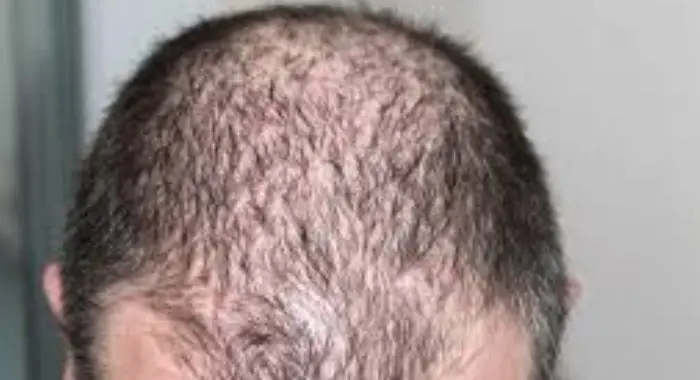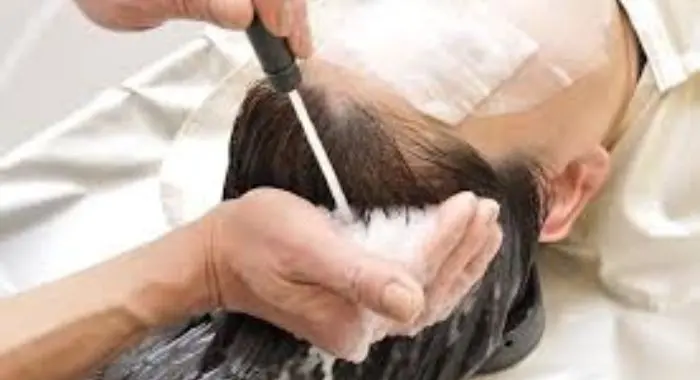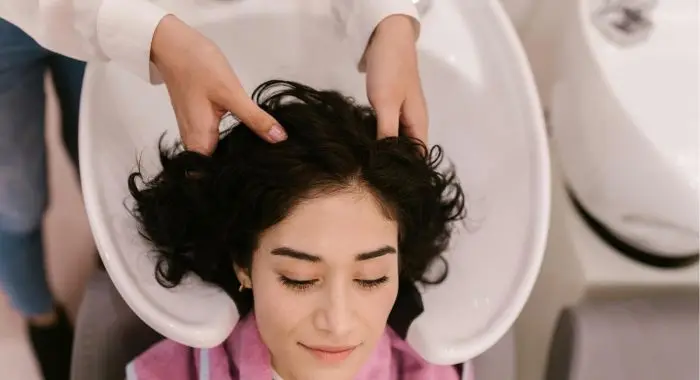As an Amazon Associate, I earn from qualifying purchases
Hair loss treatment cost is a common issue affecting millions of people worldwide, impacting not only appearance but also self-esteem and confidence.
While hair loss can be distressing, there are now more treatment options than ever before, ranging from simple over-the-counter products to advanced medical procedures.
But with so many choices, one big question remains:
How much does hair loss treatment cost?
Comprehension of the costs associated with hair loss treatments can be challenging, as they vary widely depending on the type of treatment, the severity of hair loss, and other personal factors.
Some treatments, such as topical solutions and supplements, are relatively affordable and easily accessible. While others, like hair transplants, come with a higher price tag, but can provide longer-lasting results.

In this post, we’ll break down the costs of popular hair loss treatments, explore what factors influence pricing, and offer tips on finding affordable solutions.
Factors That Influence the Cost of Hair Loss Treatments
Before diving into specific treatments, it’s essential to understand the factors that can influence costs. Here are some common elements affecting how much you’ll pay for hair loss treatments:
Type of Treatment: The hair loss treatment you choose significantly affects the price. OTC solutions like minoxidil are relatively inexpensive, while surgical options like hair transplants can be costly.
Severity of Hair Loss: More extensive hair loss often requires more comprehensive (and costly) treatments. For instance, someone with advanced balding might need a high number of grafts in a hair transplant, increasing the total cost.
Location and Clinic Reputation: Treatment costs vary depending on the clinic’s location and the practitioner’s reputation. Clinics in metropolitan areas or with well-known specialists may charge higher fees.
Additional Services: Some clinics offer additional services, such as post-procedure care, scalp treatments, or follow-up consultations, which can add to the overall cost.
Choosing the Right Hair Treatments
Choosing the right hair treatment can be overwhelming, given the wide array of options available for managing hair loss. The best choice often depends on the type and extent of hair loss, budget, lifestyle, and personal goals.
For those in the early stages of hair thinning, over-the-counter solutions like minoxidil (Rogaine) or hair-strengthening supplements may be enough to slow down hair loss and promote regrowth at a relatively low cost.
Non-invasive therapies like Low-Level Laser Therapy (LLLT) and Platelet-Rich Plasma (PRP) therapy offer alternatives to medications, stimulating hair follicles and promoting growth with minimal downtime.
These treatments, though pricier than OTC solutions, are often well-suited for individuals seeking noticeable improvements without surgery.
For those with more advanced hair loss, surgical options such as Follicular Unit Transplantation (FUT) or Follicular Unit Extraction (FUE) offer long-term, natural-looking results, albeit at a higher cost and longer recovery period.
Who Is a Good Candidate for a Hair Treatment?
A good candidate for hair treatment is someone experiencing hair loss due to factors like male or female pattern baldness, alopecia areata, or other medical conditions.
They should have realistic expectations, understanding that treatments may improve hair density but not necessarily restore a full head of hair.
Good overall health is also important, though individuals with underlying conditions may need medical consultation before starting treatment.
Tips for Finding Affordable Hair Loss Treatments
If you’re concerned about costs, here are some strategies to find affordable hair loss treatments:
Research and Compare Clinics: Prices vary between providers, so it’s worth consulting multiple clinics before making a decision.
Look for Promotions: Many clinics offer promotions or discounts on treatments, especially for first-time clients.
Consider Combination Treatments: Sometimes, combining treatments (like using minoxidil with LLLT) can provide better results and save money in the long run.
Explore Payment Plans: Financing options can make treatments more affordable by spreading out payments.
Hair Treatment Costs for FUE vs. FUT
When it comes to hair transplant costs, Follicular Unit Extraction (FUE) and Follicular Unit Transplantation (FUT) are among the most effective but vary significantly in price due to their distinct methods.
FUE is generally more expensive, with costs ranging from $6,000 to $20,000, depending on factors like the clinic’s location, the number of grafts needed, and the expertise of the surgeon.
FUE involves harvesting individual hair follicles from the donor area, a meticulous process that requires more time and precision. This technique is popular for its minimal scarring and natural results, making it a favored option for those willing to invest in a less invasive and discreet procedure.
In contrast, FUT is often more affordable, with prices typically ranging from $4,000 to $15,000. FUT, sometimes known as the strip method, involves removing a thin strip of scalp from the back of the head to obtain hair follicles, which are then transplanted to the balding areas.
Because it allows for a larger number of grafts in one session, FUT can be a cost-effective choice for those needing extensive coverage.
Ultimately, the choice between FUE and FUT depends on factors like budget, hair loss extent, and personal preference for scarring and recovery time.
Understanding Insurance and Financing Options
Most hair loss treatments are considered cosmetic and aren’t covered by insurance. However, there are some exceptions, such as when hair loss is due to medical conditions like alopecia areata.
Insurance: For specific medical hair loss conditions, insurance may partially cover treatments. It’s best to consult with your insurance provider to determine what’s covered.
Financing Options: Many clinics offer financing or payment plans, allowing patients to spread out the cost over time. These plans make expensive treatments like hair transplants more accessible, although they may include interest or fees.
Hair Treatment Costs Per Graft
Follicular Unit Extraction (FUE) and Follicular Unit Transplantation (FUT). The cost per graft can vary significantly based on the technique used, the clinic’s reputation, and geographic location.
For FUE, the cost typically ranges from $4 to $10 per graft, depending on the complexity of the procedure and the clinic’s expertise. Some clinics may offer lower rates for larger graft quantities, while others may charge more based on the intricacies of extraction and the technology employed.
Since FUE is a meticulous process that requires specialized skills and equipment, this cost can add up, especially for those needing a substantial number of grafts to achieve their desired results.
In contrast, FUT usually costs between $3 $8 per graft. This method tends to be less expensive per graft since it allows for the removal of a strip of hair follicles at once, making the harvesting process more efficient. However, the total cost will still depend on the total number of grafts needed, which can vary based on individual hair loss patterns.
When you are considering hair restoration, it’s essential to ask about the total cost, including any additional fees for consultations, follow-ups, and post-procedure care.
Choosing a Hair Treatment Surgeon and Practice
Choosing the right hair treatment surgeon and practice is one of the most crucial steps in ensuring a successful hair restoration outcome. With numerous clinics and practitioners available, navigating this decision can be overwhelming. Here are some essential factors to consider:
Credentials and Experience: It’s vital to select a surgeon who is board-certified and specializes in hair restoration. Look for professionals with extensive experience in the specific procedure you are considering, whether it’s FUE or FUT. A surgeon’s training and background in dermatology or plastic surgery can also enhance the quality of care.
Before-and-After Photos: Request to see before-and-after photos of previous patients. This visual evidence can help you assess the surgeon’s skill and the quality of their work. Pay attention to the naturalness of the results, as well as the density and placement of the grafts.
Patient Reviews and Testimonials: Research online reviews and testimonials from former patients to gauge their satisfaction with the surgeon and clinic. Websites like RealSelf and Healthgrades can provide insights into patient experiences.
Consultation Process: A thorough consultation is essential for discussing your goals and concerns. During this meeting, evaluate how attentive and responsive the surgeon is to your questions. They should provide a clear explanation of the procedure, potential outcomes, and any risks involved.
Technology and Techniques Used: Inquire about the technologies and techniques the clinic employs. Advanced equipment and techniques can enhance the quality of the procedure and improve overall results.
Facility Standards: Ensure that the practice is located in a reputable facility that meets safety and hygiene standards. Accreditation by organizations like the Joint Commission or the American Association for Accreditation of Ambulatory Surgery Facilities can indicate a higher level of care.
Is It Worth the Investment? Weighing Cost vs. Results
Hair restoration can be a significant financial commitment, with prices ranging widely based on the type of treatment, the severity of hair loss, and the expertise of the practitioner. For many individuals, the emotional and psychological benefits of restoring hair can justify the expense.
Improved self-esteem and confidence can enhance personal and professional interactions, leading to a more fulfilling life.
When assessing the value of investment in hair loss treatment, it’s crucial to consider the expected outcomes. For example, surgical options like FUE or FUT can offer permanent solutions with natural-looking results, making them appealing to those seeking long-term improvements.
However, these procedures involve higher upfront costs and require careful planning and recovery time. Non-surgical options, such as topical treatments or laser therapy, may be less expensive and less invasive but often require ongoing use to maintain results.

While some may achieve satisfying results with less invasive treatments, others may need a more comprehensive approach to address advanced thinning or baldness.
Ultimately, the decision should reflect a balance between financial considerations and the potential for improved quality of life. Consulting with a qualified specialist can provide valuable insights and help set realistic expectations, ensuring that the investment in hair restoration leads to satisfactory and fulfilling results.
Using Minoxidil
Using minoxidil is a widely recognized approach for addressing hair loss, particularly for individuals dealing with androgenetic alopecia or pattern baldness.
Available in both topical solution and foam formulations, minoxidil works by enhancing blood circulation to the hair follicles, stimulating growth, and prolonging the hair growth cycle.
To achieve optimal results, it’s essential to apply the product consistently, typically twice daily, to the areas of thinning hair on a clean, dry scalp.
While minoxidil is generally well-tolerated, some individuals may experience side effects such as scalp irritation or unwanted hair growth in other areas.
The cost of minoxidil is relatively affordable, typically ranging from $20 to $50 per month, making it an accessible option for many seeking to combat hair loss.
However, it’s advisable to consult with a healthcare provider to ensure that minoxidil is appropriate for your specific situation and to discuss any potential concerns or interactions with other medications.
Getting PRP Treatments
Getting Platelet-Rich Plasma (PRP) treatments is an innovative and increasingly popular option for addressing hair loss. This procedure involves drawing a small amount of the patient’s blood, which is then processed in a centrifuge to isolate the platelet-rich plasma.
The growth factors in PRP are believed to stimulate hair follicles, promote hair growth, and improve the overall health of the scalp. Treatments typically take about 30 to 60 minutes, with minimal downtime, allowing patients to resume their regular activities shortly afterward.
Many individuals begin to notice improvements in hair density and thickness within three to six months, with results continuing to develop over time.
It’s most important to note that PRP therapy is not a miracle cure for hair loss. It works best for people with early-stage hair loss and may not be effective for everyone.
Additionally, results can vary depending on factors such as the severity of hair loss, individual response to treatment, and the skill of the healthcare provider administering the treatment.
Compare hair loss treatments for informed choices.

It’s important to note that while these alternative approaches may help some individuals, they may not work for everyone. Consulting with a healthcare professional is crucial to determine the best course of action for your specific needs.
Potential Side Effects
While hair loss treatments can be effective, they may also come with potential side effects. Here are some common side effects associated with different treatments:
Medications (Minoxidil, Finasteride)
- Minoxidil:
- a. Scalp irritation
- b. Unwanted hair growth on the face or body
- c. Dizziness
- d. Rapid heartbeat
- Finasteride:
- a. Decreased sex drive
- b. Erectile dysfunction
- c. Decreased volume of ejaculate
- d. Depression
Hair Transplant Surgery
- Bleeding
- Infection
- Scarring
- Swelling
- Numbness
- Pain
Laser Therapy
- Scalp irritation
- Redness
- Mild pain
Platelet-Rich Plasma (PRP) Therapy
- Mild pain or discomfort
- Bleeding
- Bruising
- Infection

It’s important to consult with a healthcare professional to discuss the potential risks and benefits of any hair loss treatment before starting.
Frequently Asked Questions (FAQ) about Hair Loss Treatment Costs
Quest: Are there any hidden costs associated with hair loss treatments?
Ans: Always ask about the full scope of costs during your consultation. Some clinics may charge additional fees for consultations, follow-up visits, medications, or post-treatment care.
Quest: How long do results from hair loss treatments last?
Ans: The longevity of results depends on the type of treatment. Non-surgical treatments may require ongoing use to maintain results, while surgical options like hair transplants can provide permanent results.
Quest: Does insurance cover hair loss treatments?
Ans: In most cases, hair loss treatments are considered cosmetic procedures and are not covered by health insurance. However, it’s essential to check with your insurance provider for specific coverage details, as some policies may offer limited coverage for certain medical conditions leading to hair loss.
Final Thoughts
Understanding the cost of hair loss treatment is essential for anyone looking to take control of their hair health. The financial commitment can range from just a few dollars per month for basic over-the-counter products to several thousand dollars for advanced medical procedures like hair transplants or laser therapy.
These wide-ranging prices reflect not only the diversity of treatment options but also the varying levels of effectiveness, duration, and personal suitability.
While cost is a major consideration, it should not be the only factor in your decision-making process. Effectiveness, potential side effects, convenience, and long-term maintenance are all crucial elements to weigh alongside your budget.
For example, topical treatments like minoxidil may be relatively inexpensive and easy to access but require ongoing use to maintain results.
Before committing to any treatment, it’s wise to consult with a dermatologist or hair restoration specialist. A professional can assess your condition, recommend the most effective options, and provide a clearer picture of the expected costs over time.
In some cases, combining multiple treatments may yield better results, which can also influence the total investment.
In the end, the best hair loss treatment is the one that fits your personal needs, goals, and financial situation. By taking the time to research and understand your options, you can make a well-informed decision that offers both value and peace of mind on your journey to healthier hair.
As an Amazon Associate, I earn from qualifying purchases
